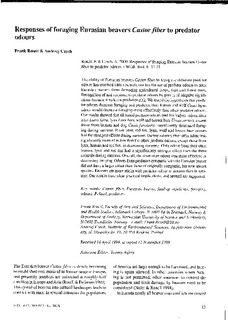| dc.description.abstract | The ability of Eurasian beavers Castor fiber to recognise different predator odours has received little research, nor has the use of predator odours to deter Eurasian beavers from damaging agricultural crops, fruit and forest trees. Recognition of and response to predator odours by prey is of adaptive significance because it reduces predation risk. We tested the hypothesis that predator odours decrease foraging and predicted that: human and wolf Canis lupus odour would decrease foraging more effectively than other predator odours. Our results showed that all tested predator odours (red fox Vulpes vulpes, river otter Lutra lutra, lynx Lynx lynx, wolf and brown bear Ursus arctos), except those from human and dog Canis familaris, significantly decreased foraging during summer. River otter, red fox, lynx, wolf and brown bear odours had the strongest effects during summer. During autumn, river otter odour was significantly more effective than the other predator odours, except those from lynx, human and red fox, in decreasing foraging. Only odour from river otter, human, lynx and red fox had a significantly stronger effect than the three controls during autumn. Overall, the river otter odour was most effective in decreasing foraging. Odours from predators sympatric with the Eurasian beaver did not have a larger effect than those of originally sympatric, but now absent species. Beavers ate more sticks with predator odour in autumn than in summer. Our results have clear practical implications, and several are suggested. | |
